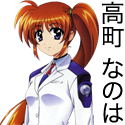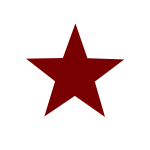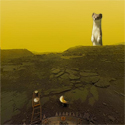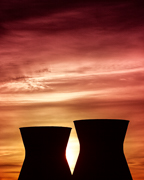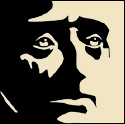|
Jekub posted:If you add up the cost of an SBIG STF-8300 plus a filter wheel and the 2" filters you would need to avoid vignetting then the QSI suddenly starts to look quite reasonable (for a given value of reasonable). https://www.sbig.com/products/cameras/stt/ $4500 (£2800) w/ wheel, $4900 (£3000) kitted with Baader filters. (Haha, never loving mind, it goes past $5000 when you want the promised self-guiding, I didn't click enough, at which point the QSIs are still $3700-$3900 with OAG builtin) Wolf on Air fucked around with this message at 15:38 on Oct 4, 2013 |
|
|
|

|
| # ? May 30, 2024 21:02 |
|
The PacMan nebula in HA, taken with my QSI-583 and a Baader 7nm HA filter. A rough first process of what will hopefully be a full image further down the road when I have the rest of the narrowband filter set. Everything mostly working OK for once, though for some reason my declination likes to randomly swap which direction it's drifting which is a bit bizarre. I may have to slightly misalign the mount to keep the declination drift in one direction as unbalancing the dec axis hasn't helped. NGC281 in HA by tmarkuk, on Flickr
|
|
|
|
This kinda counts as space, I guess? My wife and I just got back from the Okie-Tex Star Party in Kenton, OK near Black Mesa State Park. A good, if cold, time was had. An old coworker gave me an old Nikon D70, and I rented a 10-24mm lens for use on the trip. I used to photograph things fairly frequently, but haven't even owned a non-cell phone camera in about 5-6 years. Anyway, this is a photo (well, 4 photos stitched together - 2 of the sky, 2 of the foreground) of the view of the campsite from the top of a surrounding cliff. The camera was obviously "well used" before I got it, and night photography was pretty much completely broken. Oh well. 
|
|
|
|
Kind of short notice, but asteroid 617 Patroclus will be occulting a 9th magnitude star in Ares for a pretty wide swath of the US from North Carolina to California. Sky & Telescope article here and a Google Maps image of the ground track here. Patroclus is a binary asteroid, making it's uncertain where the ground track for the two actually fall, so observations have been requested from a few hundred miles on either side of the center line, just to be safe.
|
|
|
|
Been following this thread for a while now, and I just wanted to pop in and mention that I finally bit the bullet and ordered one of those Celestron Firstscopes to see if I have the right stuff. I've never put my face up to a tube before but I'm pretty stoked to check out some moon poo poo, at the very least. My short list of targets also includes some basics like Polaris, a few planets, and the Orion nebula. As I said this is something of an experiment to see if I can handle it, especially now that it's getting cold in the midwest, but I'll definitely be checking back after the scope arrives. Also my hat is off to all you AP people (jekub, mr. despair, venusian weasel, etc.) keep up the great work, it's really inspiring.
|
|
|
|
Be prepared for cloudy weather for at least a week after your scope arrives.
|
|
|
|
Seqenenra posted:Be prepared for cloudy weather for at least a week after your scope arrives. Right you are, the last couple of nights have been crystal-clear, and now that I have it... rain. Oh well, I've still had a chance to sight in and play with the lenses. Nice little scope.
|
|
|
|
My first mostly full narrow band image attempt with the QSI-583ws. NGC281 in Narrow Band Hubble Palette by tmarkuk, on Flickr A great deal of learning to do yet, but it's off to a good start I think.
|
|
|
|
That's not a good start, that's a great start.
|
|
|
|
Jekub posted:My first mostly full narrow band image attempt with the QSI-583ws. Off to a great start I would say. Which telescope did you use for that? How dark are your skies where you live?
|
|
|
|
Fairly clear tonight. Set up on a bench in the back yard and sighted in on a few objects. Had a little trouble resolving what I believe was Jupiter rising in the east. The best I could get was a blurry orb with a sort of ghostly spiderweb around it. Frost on the mirror and lens was a concern. Can't wait for the moon to come out at a decent hour.
|
|
|
|
Jekub posted:My first mostly full narrow band image attempt with the QSI-583ws.
|
|
|
|
That one was taken with my 250mm F4.8 reflector, from my back garden in Basingstoke, UK. So horrible light pollution especially since they replaced all the street lights with broad spectrum white lights. The narrowband seems mostly unaffected which is nice. As for the star colour, I would love to set those back to something more natural but the diffraction spikes make building a suitable mask extremely difficult. The standard star mask in Pixinsight won't pick them up but I'm trying to find a way of doing it. I could just go with another palette and aim for a more natural look all around. I may try doing some aimed hue adjustment on them instead but that always tends to end of having effects across the image. Jekub fucked around with this message at 10:23 on Nov 4, 2013 |
|
|
|
Quote is not edit....
|
|
|
|
I don't know about the color, but that picture looks pretty badass. Especially if light pollution is an issue there.
|
|
|
|
Camera etc : I love the QHY5L-II-M, it's a beast. I've yet to point it anywhere and not have a something I can guide off. I need to try some planetary work with it at some point.
|
|
|
|
Could try it out on some comets... I wish it weren't so cloudy here. I was going to try and get some of Comet Lovejoy with my telephoto since it's fairly bright (almost naked eye) at the moment. Would also be good practice for ISON. Venusian Weasel fucked around with this message at 09:40 on Nov 7, 2013 |
|
|
|
Time to play "Spot the Comet!" Comet Lovejoy and the Beehive by venusian-weasel, on Flickr EDIT: Here's a better version, I've been experimenting with different stacks and stuff:  Comet Lovejoy and the Beehive by venusian-weasel, on Flickr Venusian Weasel fucked around with this message at 00:28 on Nov 8, 2013 |
|
|
|
Here's a cool shot of the moon I grabbed a couple of weeks ago. Iphone and an Orion XT8, but I don't recall which eyepiece I used. 
|
|
|
|
I saw the zodiacal light for the first time ever yesterday morning. It was pretty obvious, so I'm kind of surprised I've never recognized it before. Zodiacal Light by venusian-weasel, on Flickr Also been trying to figure out the best way to shoot comets without a tracking mount. This is the best I've been able to do so far.  Comet ISON by venusian-weasel, on Flickr Venusian Weasel fucked around with this message at 22:00 on Nov 11, 2013 |
|
|
|
Astrophotography goons! I want to take space photos! I eventually want a nice telescope for astrophotography...but I'll be moving across the country in about 8 months. I don't really want to get a telescope now and either take it with me or try to sell it. Is it possible to break into the hobby with a dslr, decent telephoto lens, tripod and image stacking? I would obviously have to manually reposition the shot every X minutes, but I'm ok with that. If it's doable, what's the bare minimum for a decent lens? Should I prioritize speed or focal length? E.g. go get that slow 800mm f9.9, or take the fast(er) 300mm f4.5? Is it impossible to use large focal lengths without a tracking mount anyway?
|
|
|
|
If you're just getting started, and don't want tons of equipment to deal with right now, your best bet is a DSLR with a telephoto, and a tracking mount for your tripod. The tracking mount costs around $400, but if you're able to spring for an 800mm telephoto, you should be able to afford it. Honestly, a 300mm telephoto should be more than enough for your purposes. More than that and you're throwing money down the drain that you could be spending on a cool telescope setup. If you're looking for a new camera, look for something with a good performance at high ISO.
|
|
|
|
Venusian Weasel posted:If you're just getting started, and don't want tons of equipment to deal with right now, your best bet is a DSLR with a telephoto, and a tracking mount for your tripod. The tracking mount costs around $400, but if you're able to spring for an 800mm telephoto, you should be able to afford it. Great, thanks! I'll start investigating mounts while playing around with moon photography. And squirreling the rest of my money away for the (eventual) dobsonian telescope, once I get settled down somewhere in the western US (Idaho/Montana/Colorado probably...little light pollution, I'm so excited!) I recently acquired a Sony NEX-5n, which has great high ISO performance and one of the things that kickstarted my idea to use it for astrophotography. My plan was to pick up a vintage telephoto lens...autofocus isn't really needed for stars right? I can just focus to infinity on the manual lens. If I can go the vintage lens route I can save some serious cash. Old telephotos are surprisingly cheap, especially the prime lenses.
|
|
|
|
I don't know if it's just my telephoto, but mine focuses *just* past infinity, so I have to take a few minutes to make sure that everything is indeed in focus. If you've got a liveview with a high framerate, it's not very hard to do.
|
|
|
|
polyfractal posted:Astrophotography goons! I want to take space photos! In my opinion you'd actually fair better using a long lens on the moon and a very wide angle lens wide open to shoot some broad skyscapes first as an intro if you didn't have a powered mount and stack. The rule of thumb is 300/focal length = maximum exposure in seconds without substantial star trailing if you aren't using a tracking mount. Some would argue the results aren't the same substituting fewer long exposures for a very very large number of shorter exposures, but you can still achieve a lot if you are prepared to stack enough images to accumulate a long (say more than 20min) total exposure time through stacked frames. You could do some deep space stuff too but the process becomes much more involved. Of course tackling technical challenges is part of the fun of astrophotography! This video is a decent intro to the sort of thing you are talking about https://www.youtube.com/watch?v=e0JSTF8SGi4 You might find this interesting too which gives a sense of what different focal lengths will frame in the night sky: http://www.pbase.com/samirkharusi/focal_lengths Venusian Weasel's post above is also good example of the difference in difficulty from wide angle to deeper sky shots. He pulled a really interesting zodiacal light photo there, but was finding it much more difficult shooting comet ISON without introducing star trails.
|
|
|
|
Page Downfall posted:In my opinion you'd actually fair better using a long lens on the moon and a very wide angle lens wide open to shoot some broad skyscapes first as an intro if you didn't have a powered mount and stack. The rule of thumb is 300/focal length = maximum exposure in seconds without substantial star trailing if you aren't using a tracking mount. The second link is really awesome, thanks! Nice to see what different focal lengths can potentially achieve. I didn't realize that such wide angles could achieve good shots of nebulae and galaxies...assumed it was limited to generic star fields. I have a few lenses, although unfortunately two of them are zooms. After correcting for crop-factor:
I'm all for taking a billion shots and stacking. Would rather play around with basic equipment than spend a bunch on a mount and never use it. I tend to be pretty ADHD about new hobbies...known character flaw  If I can get cool photos with basic equipment I think I'll have a better chance sticking around and adding this to my "permanent" hobby list (and then start hemorrhaging money) If I can get cool photos with basic equipment I think I'll have a better chance sticking around and adding this to my "permanent" hobby list (and then start hemorrhaging money)Also, apologies: I've been back-reading the thread and noticed about 50% of the posts are "OMG I want to astrophotography...what gear should I buy?!" Looks like I piled onto the bandwagon 
polyfractal fucked around with this message at 18:24 on Nov 17, 2013 |
|
|
|
To contribute something to the thread, here is my first attempt at a moon photo: Stack of 22 images: 300mm @ f/3.8, 1/800s, 3200 ISO. Forgot to change the ISO, the moon was so bright I could have gotten away with something much lower. Aligned with PixInsight FFTAlignment, then run through the Deconvolution filter (300 iterations Regularized Richardson-Lucy) and finally tweaked in Lightroom. The deconvolution gave the entire moon a bit of a halo and nasty aliasing effects (not sure how to get rid of it and/or prevent it in the first place). PixInsight is...extremely complicated. It's going to take a long time before I feel comfortable working in that program. Excited to someday understand what the hell most of the stuff does!
|
|
|
|
My astrophotography shenanigans mostly consist of using my iPhone with an afocal adapter and taking HD video and stacking in Registax. I'm upgrading to a 5S in two weeks and getting a Magnifi afocal adapter to go with it. It'll be interesting to see what kind of results I get with the 120 fps capture at 720p. I gravitate towards iPhone afocal photography for the same reason I like QRP ham operation. I like the challenge of using a bare minimum of equipment and seeing just how far I can push it.
|
|
|
|
polyfractal posted:To contribute something to the thread, here is my first attempt at a moon photo: If your focus is sharp and your tripod is stable you shouldn't need to use deconvolution, and at 1/800 your image should be steady anyway. So I'd suggest having a close look at your frames and working out if the images are in focus first. You should be able to shoot the full moon at a much slower shutter speed/lower ISO. I don't know what you're shooting with, but most DSLRs have a better noise profile at 800 ISO or below.
|
|
|
|
polyfractal posted:PixInsight is...extremely complicated Stick with it, look up Harry's tutorial videos if you have not already, an excellent way to get started. I spent the weekend taking my CGEM apart again trying to work out what is wrong with the dec axis. I am seriously thinking of swapping up to an EQ8 or a Losmandy G11.
|
|
|
|
Was looking for ISON updates, and bumped into this hilarious channel: http://www.youtube.com/user/BPEarthWatch So what are peoples plan for next week's closeup?
|
|
|
|
Jamsta posted:Was looking for ISON updates, and bumped into this hilarious channel: http://www.youtube.com/user/BPEarthWatch He should get an award for packing that much woo into one video. And to think that I wasted all those years searching for submarines using sonar instead of ELF radio waves.
|
|
|
|
Jamsta posted:Was looking for ISON updates, and bumped into this hilarious channel: http://www.youtube.com/user/BPEarthWatch Well, I'm going to be celebrating Thanksgiving where there isn't great phone service, so I won't be on the internet much, but if I do manage to get a signal I'll probably be checking in occasionally on Karl Battams' twitter feed (@SungrazerComets), since he's in charge of comet observations for the SOHO coronagraphs and coordinating an observing campaign with the STEREO coronagraphs and the Solar Dynamics Observatory. He'll probably be a one-stop shop for just about any pictures or video from the spacecraft.
|
|
|
|
Venusian Weasel posted:Well, I'm going to be celebrating Thanksgiving where there isn't great phone service, so I won't be on the internet much, but if I do manage to get a signal I'll probably be checking in occasionally on Karl Battams' twitter feed (@SungrazerComets), since he's in charge of comet observations for the SOHO coronagraphs and coordinating an observing campaign with the STEREO coronagraphs and the Solar Dynamics Observatory. He'll probably be a one-stop shop for just about any pictures or video from the spacecraft. Thanks for the Sungazer comets twit, I followed that and it recommended @ISONUpdates Saw this little number retweeted: https://twitter.com/FailedProtostar/status/403130085886021632/photo/1 
|
|
|
|
Comet Lovejoy the night before last.  Comet Lovejoy 11-20 by venusian-weasel, on Flickr
|
|
|
|
Hmm, so I think my camera may be fundamentally incompatible with astrophotography, for silly logistical reasons:

polyfractal fucked around with this message at 20:55 on Nov 22, 2013 |
|
|
|
polyfractal posted:The LCD is blinding and kills night vision...is there a red transparency cover I can tape to it or something? http://www.optcorp.com/os-ruby-rubylith-red-masking-film-15inch-x-20inch-sheet.html
|
|
|
|
polyfractal posted:Hmm, so I think my camera may be fundamentally incompatible with astrophotography, for silly logistical reasons: It's not the greatest thing, but you can can jack the ISO way up and take a frame a few seconds long, get your bearings and check your focus on the image and adjust. Repeat until you're happy with the framing/focus and then turn set it to something more reasonable and shoot your proper frames.
|
|
|
|
Holy crap I took pictures of stars!   Picked some arbitrarily bright stars visible from my backyard and took another crack at astrophotography. It's not a fantastic image...but it's a star field! Pretty excited  I thought I was looking at Alpha Arietis right in the center of the image, but now I'm not so sure. I was using an ipad app to identify the star and I'm really not sure how accurate the tracking is. Need to get an actual astronomy book and learn how to navigate the stars better  Also think something went wrong with either the stacking/registration or my aperture was too large...the stars become increasingly elongated as you move towards the corners, especially the top right. I don't think it was too long of an exposure (70mm at 4s, which should be well under the 600 rule of 8s)
|
|
|
|

|
| # ? May 30, 2024 21:02 |
|
Looks like Aries to me.
|
|
|



